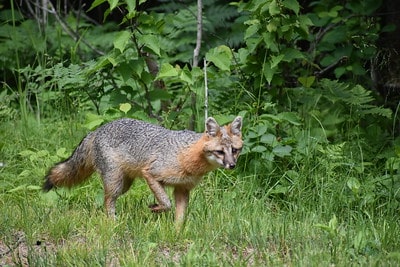What are the laws for hunting fox in Utah? This article covers many of the fundamental laws you will need to know to get started. It also provides information such as seasons, harvest limits, and required permits for bobcat hunting in Utah. It is not a legal document and is not intended to cover all hunting laws and regulations.

In Utah, the Kit and Gray fox hunting season runs from September 18th to March 1st. Red fox may be hunted all year. A valid furbearer hunting license is required to take Kit and Gray fox, but is not required for red fox. There is no bag limit.
Purchase a Utah hunting license here.
Check out all the Utah hunting seasons.
First time hunting fox? Check out these articles:
Read: How to call in a fox.
Read: How to use tracks and scat to hunt a fox.
Related: Read the laws for hunting coyotes in Utah.
Related: Read the rules for hunting bobcats in Utah.
General laws for hunting fox in Utah.
Suppressors. Legal for use while hunting foxes.
Night hunting. Prohibited for the hunting of fox. Harvesting furbearers by shooting or with the aid of dogs is restricted to 30 minutes before sunrise to 30 minutes after sunset, unless you have a permit from the county to spotlight coyote, red fox, striped skunk or raccon.
Electronic callers and decoys. Appear to be legal at this time. Please check for updates and changes.
While electronic callers are expensive, mouth and hand callers are cheaper but harder to use.
Read this article and watch the video to learn how to use a closed reed rabbit squealer.
Follow along as call manufacturer Brian Rush shows you three open reed calls you can learn and use today.
You can check the price for an electronic caller on Amazon.
Related: You can read about some highly effective but inexpensive ($20) decoys here.
Other laws that you need to heed when hunting fox in Utah.
Trespassing.
While taking wildlife or engaging in wildlife-related activities, you may not— without permission—enter or remain on privately owned land that is:
• Cultivated.
• Properly posted.
• Fenced or enclosed in a manner designed to exclude intruders
In addition, you may not:
• Enter or remain on private land when directed not to do so by the owner or a person acting for the owner.
• Obstruct any entrance or exit to private property.
“Cultivated land” is land that is readily identifiable as a land whose soil is loosened or broken up for the raising of crops, land used for the raising of crops, or a pasture that is artificially irrigated.
“Permission” means written authorization from the owner or person in charge to enter upon private land that is cultivated or properly posted. Permission must include all of the following details:
• The signature of the owner or person in charge
• The name of the person being given permission
• The appropriate dates.
• A general description of the land “Properly posted” means that signs prohibiting trespass—or bright yellow, bright orange, or fluorescent paint—are clearly displayed at all corners, on fishing streams crossing property lines, and on roads, gates, and rights-of-way entering the land. Or they are displayed in a manner that is visible to a person in the area.
You may not post private property you do not own or legally control or land that is open to the public as provided by Utah Code § 23-21-4.
In addition, it is unlawful to take protected wildlife or its parts while trespassing in violation of Utah Code § 23-20-14.
You are guilty of a class B misdemeanor if you violate any provision described in this section. Your license, tag, or permit privileges may also be suspended.
Related: Learn how to ask for permission to hunt private property here.
Places where you cannot shoot a firearm fox hunting in Utah.
You may not discharge a dangerous weapon or firearm under any of the following circumstances:
• From a vehicle.
• From, upon, or across any highway.
• At power lines or signs.
• At railroad equipment or facilities, including any sign or signal.
• Within a Utah state park camp or picnic sites, overlooks, golf courses, boat ramps, or developed beaches.
• Without written permission from the owner or property manager, within 600 feet of:
• A house, dwelling, or any other building.
• Any structure in which a domestic animal is kept or fed, including a barn, poultry yard, corral, feeding pen, or stockyard.
Related: Help a farmer out—teach them how to kill a fox that’s eating their chickens.

